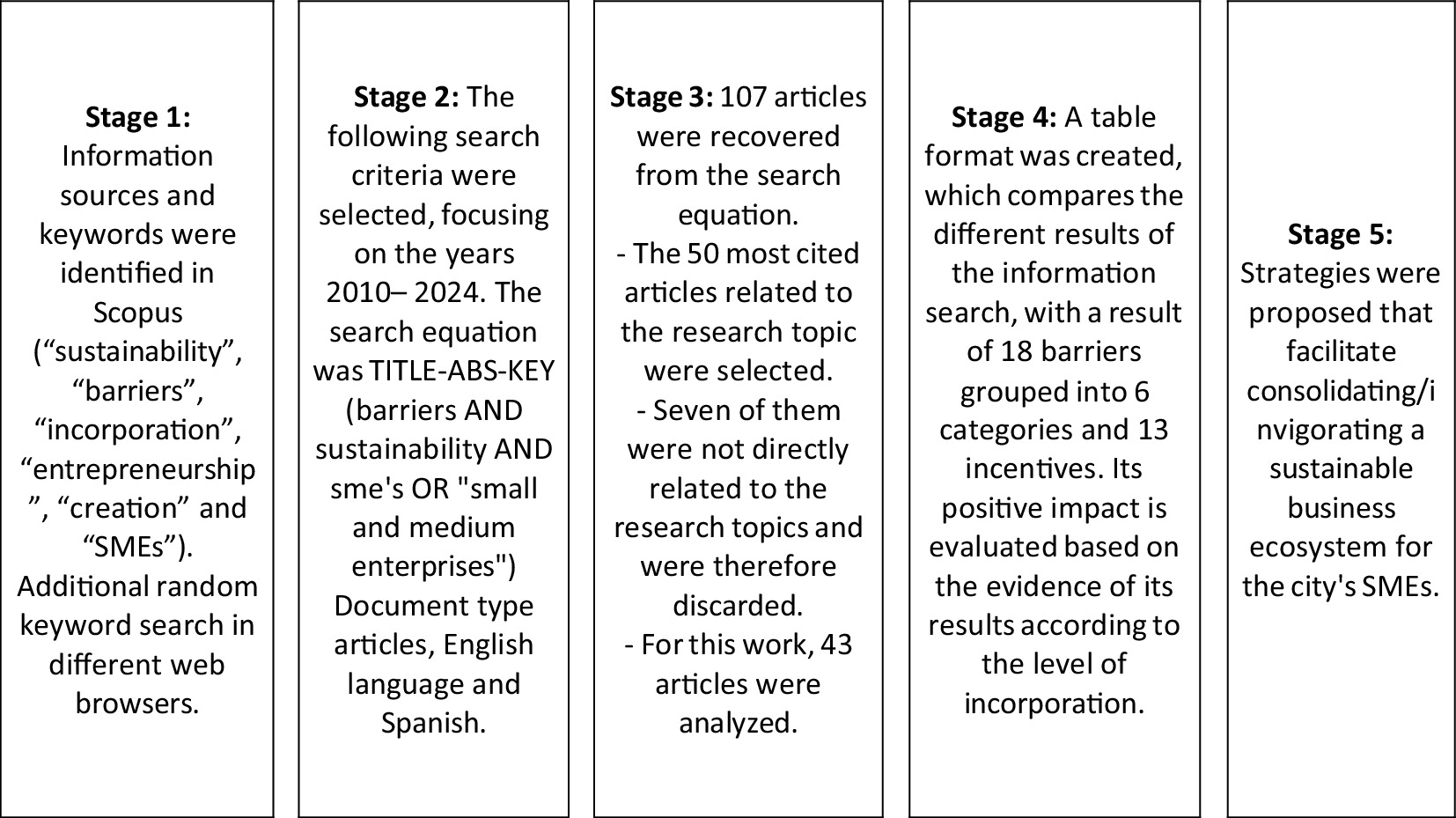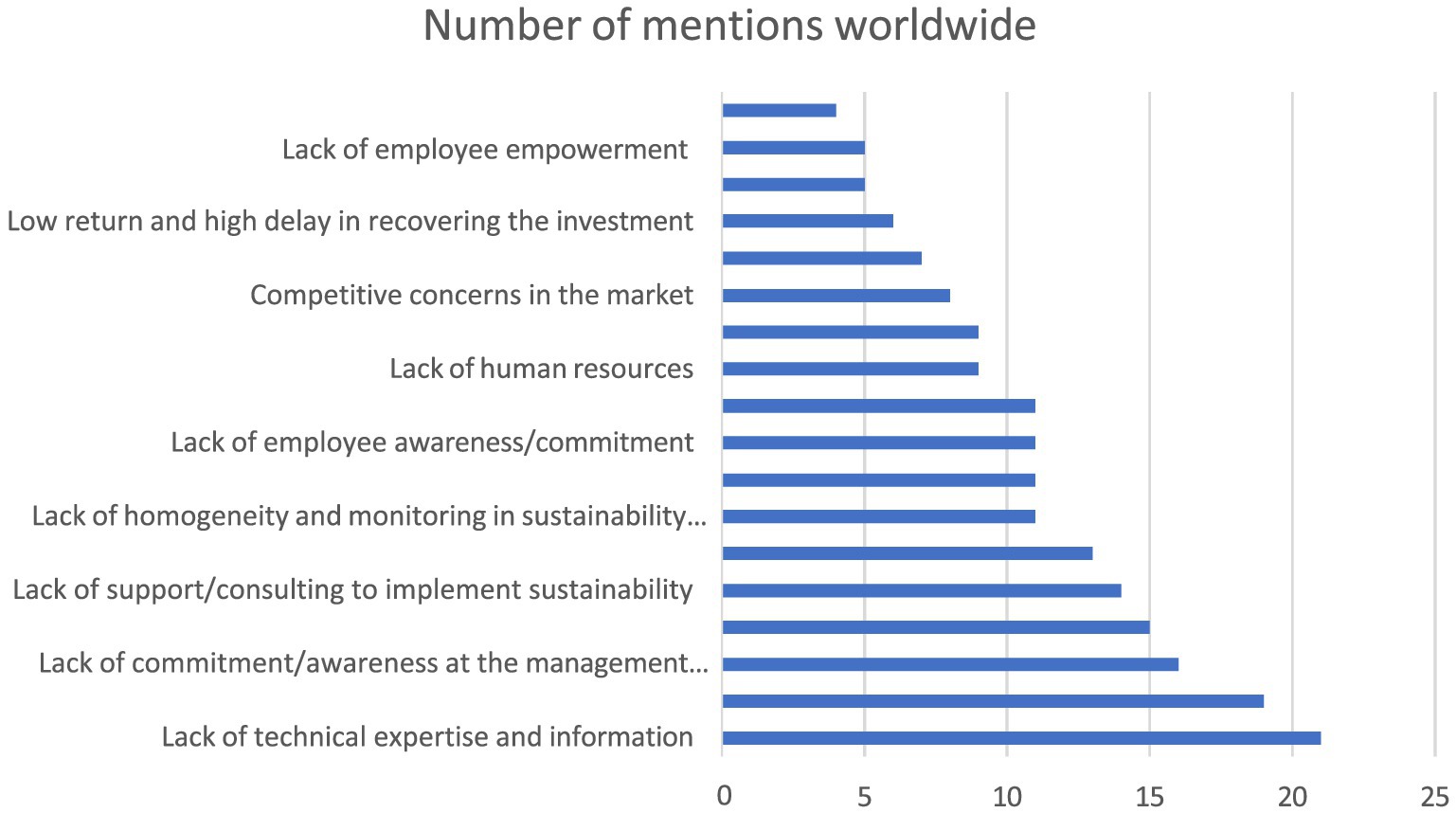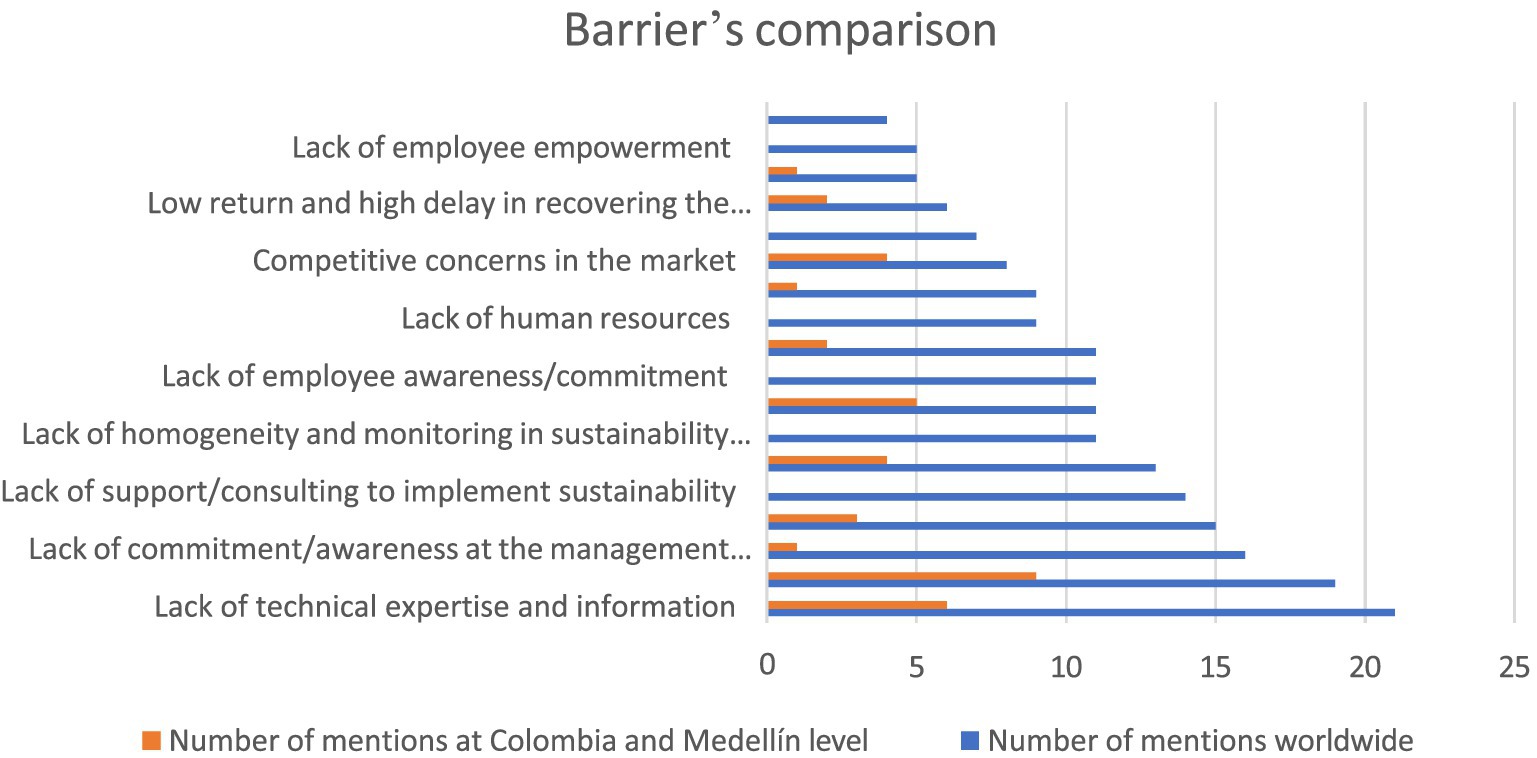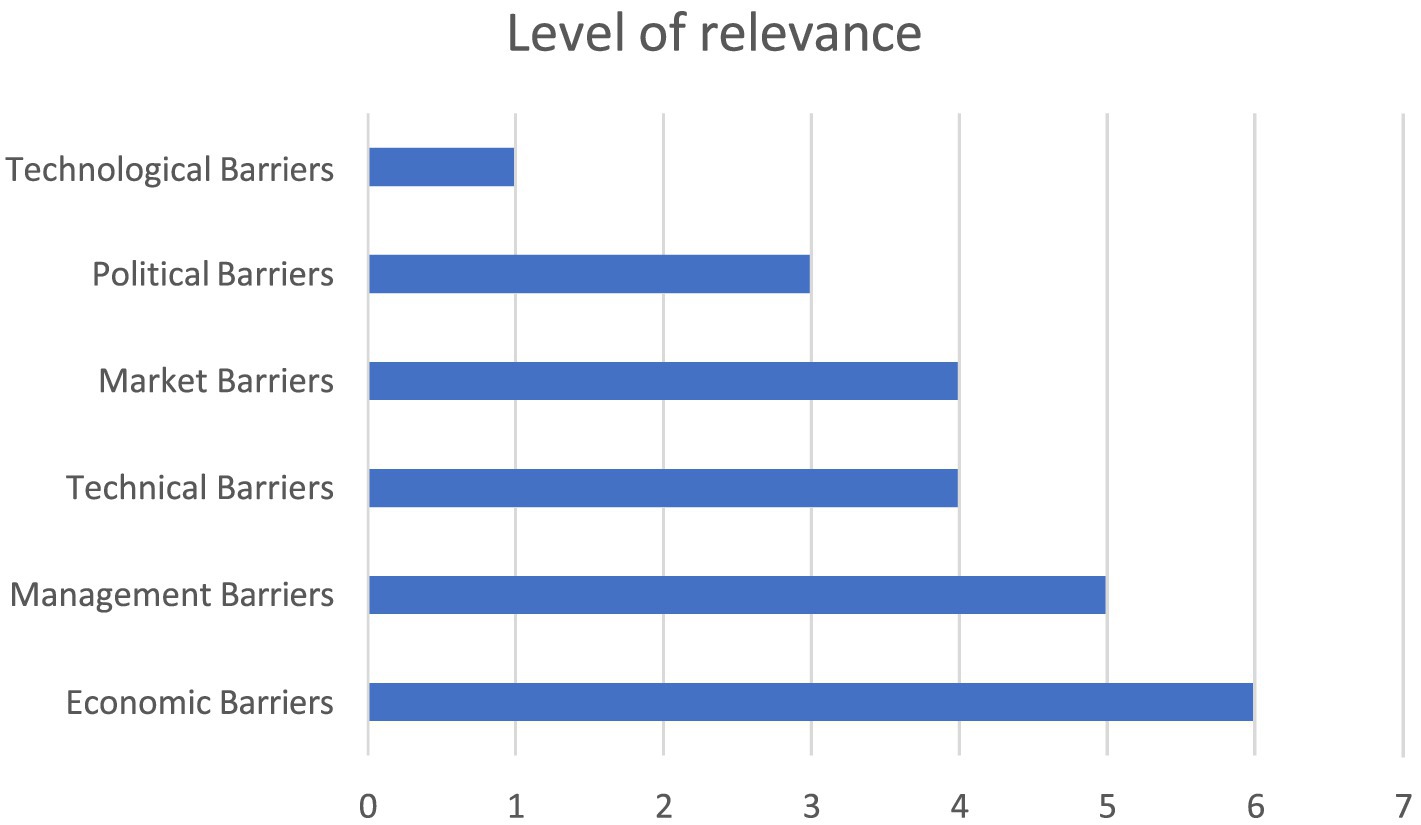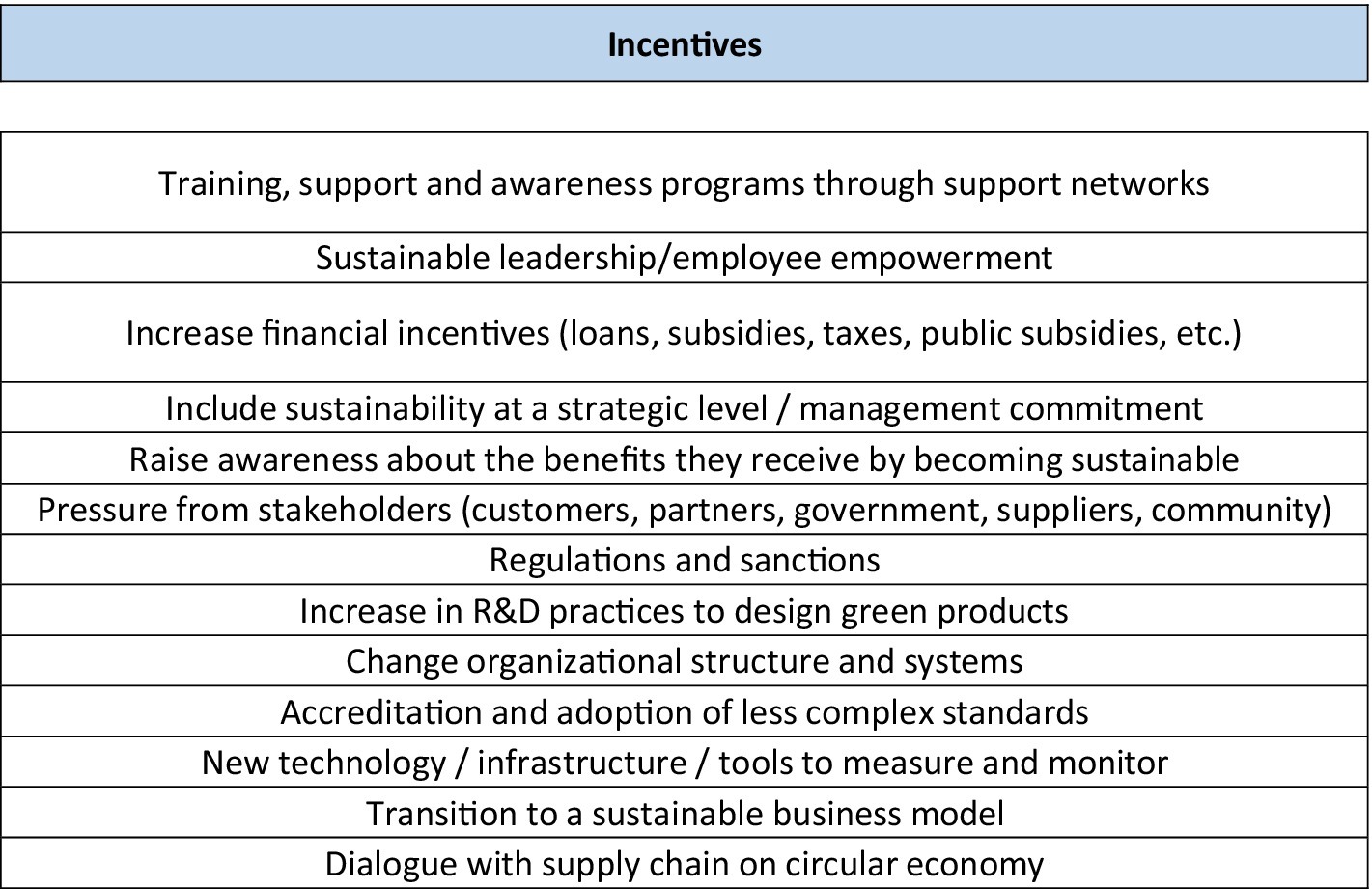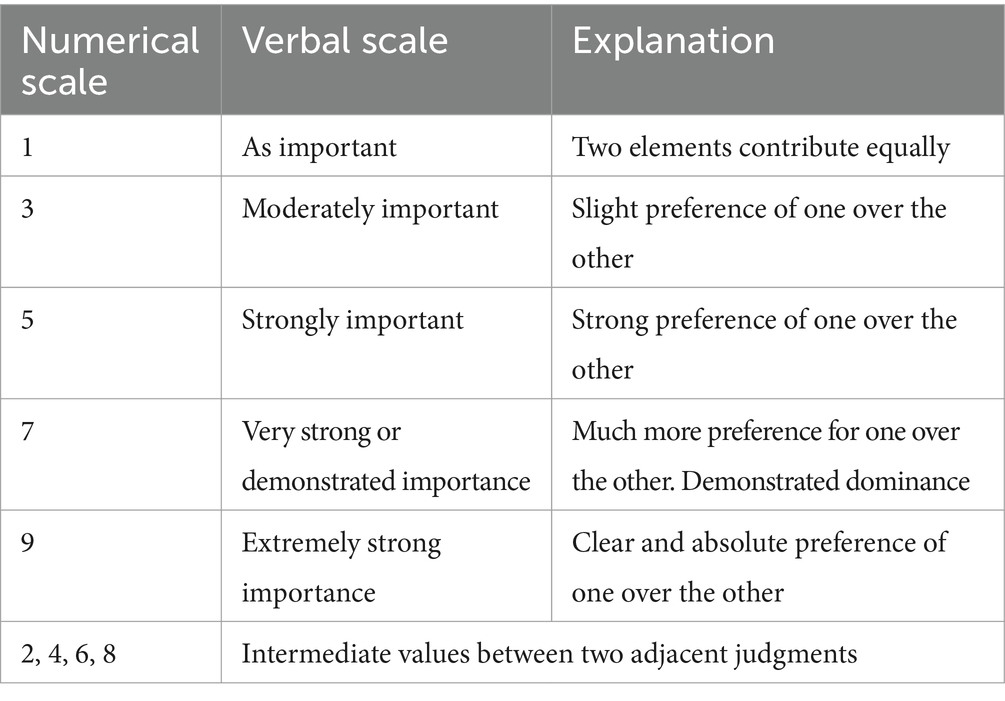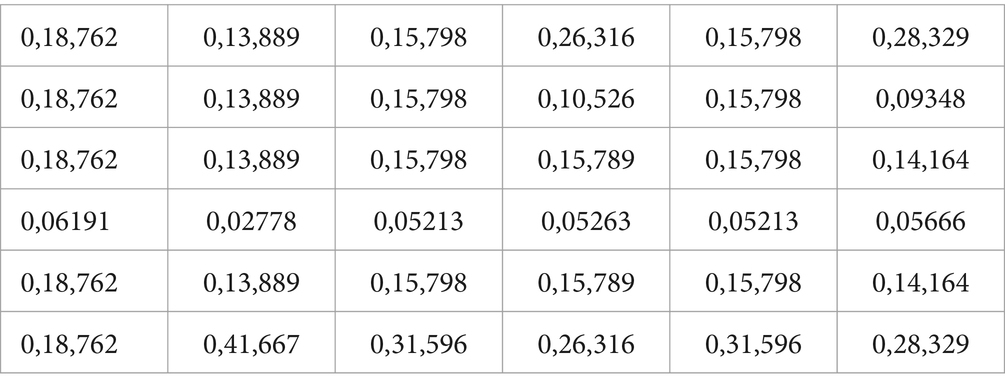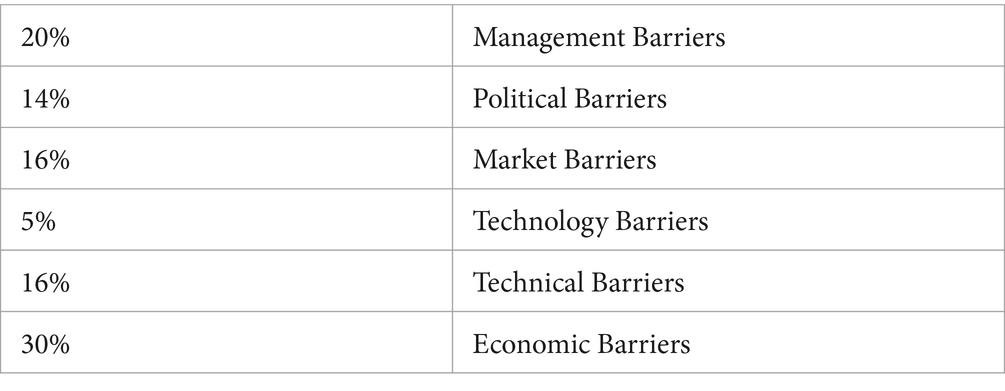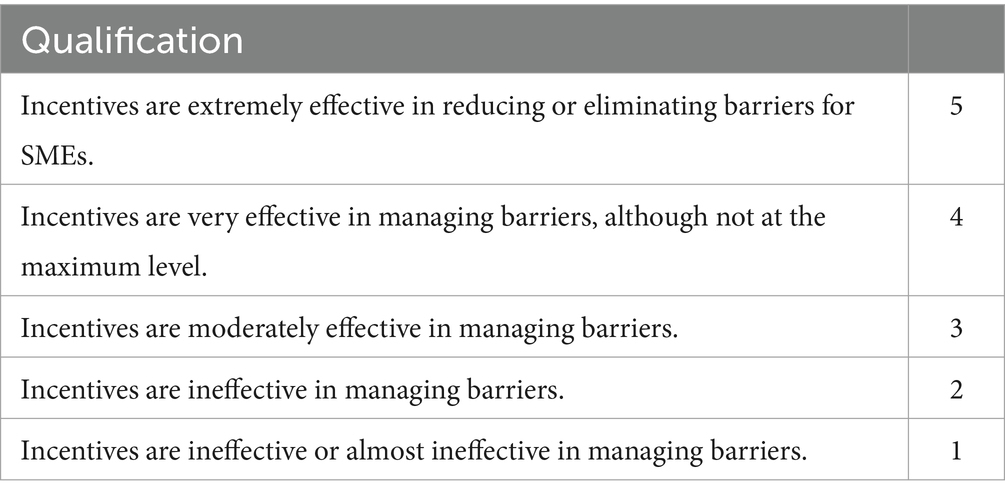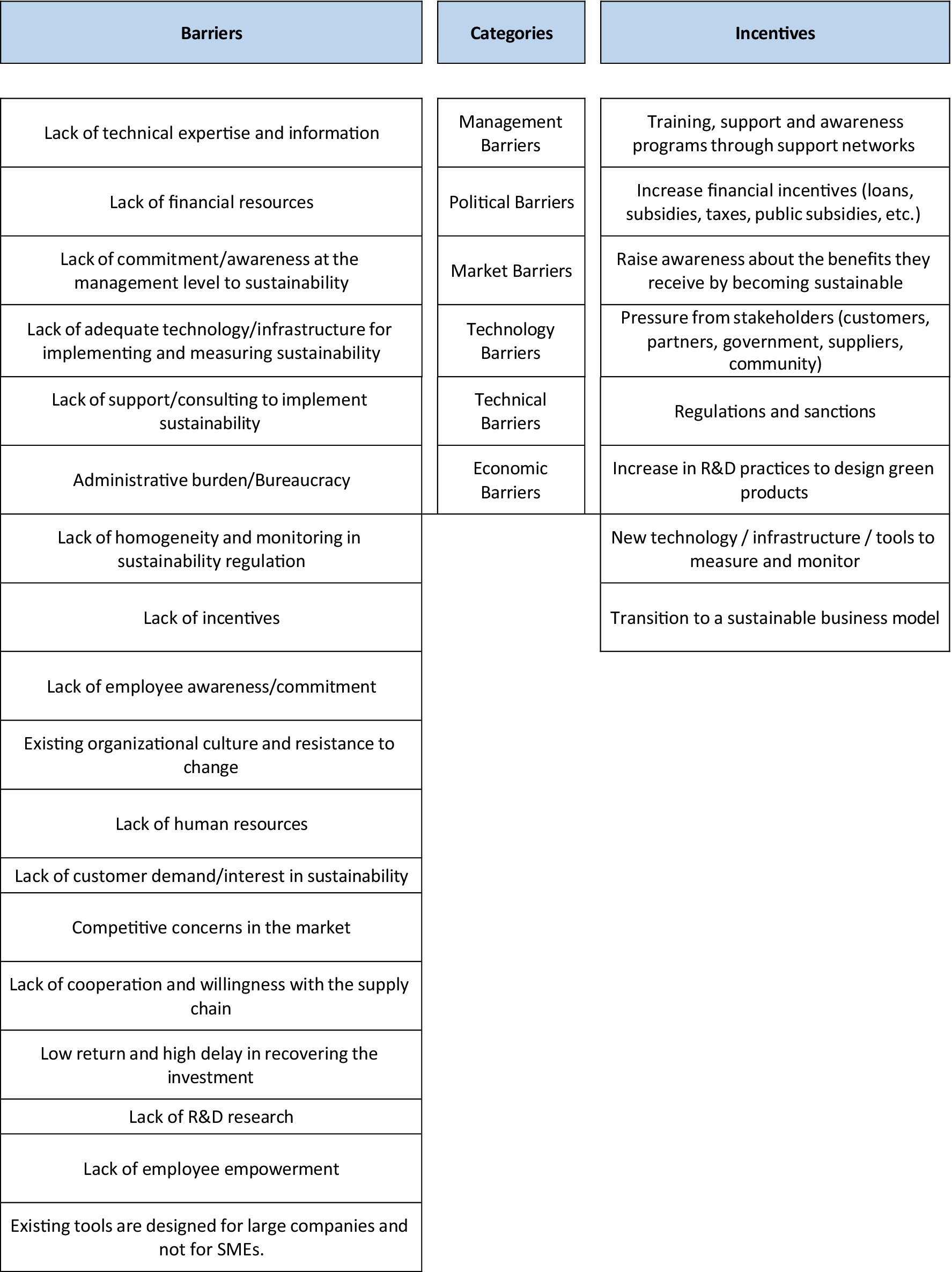- Faculty of Agroindustrial Engineering, School of Engineering, Pontifical Bolivarian University, Medellín, Colombia
A confluence of internal and external factors has contributed to a growing optimism regarding the viability of sustainability positions, evidenced by a proliferation of studies on this topic at the global level. We integrate this comprehension with the pivotal function that SMEs perform within the business network of the city of Medellín and examine the extent of their engagement with sustainability issues. This study examines the obstacles that small and medium-sized enterprises (SMEs) encounter globally and contrasts them with the incentives that various actors, including government agencies and private entities, implement to address these types of obstacles. A search of SCOPUS using the equation and the definition of the keyword “sustainability,” along with the terms “barriers,” “incorporation,” “entrepreneurship,” “creation,” and “SME,” yielded 107 articles. The 50 most cited articles related to the research topic were selected; however, seven of them were found to be irrelevant to the research topic and were thus excluded. Consequently, 43 articles were subjected to analysis for the purposes of this study. The focus of this study is centered on Colombia, specifically in the city of Medellin, the capital of the Antioquia department. For this purpose, we have standardized both the barriers and incentives reviewed, resulting in 18 barriers and 13 incentives. The AHP model was employed to ascertain the level of importance of each barrier, group them into six categories, and evaluate and compare the incentives in terms of their efficacy in addressing these barriers. Based on these findings, strategies are proposed to enhance the company’s market position and competitive advantage, thereby fostering a more robust business network in the city.
Introduction
Today, although there is increasing pressure from governments and markets for companies to incorporate sustainability aspects into their operations, the current level of adoption remains low, and responsibility for this issue is often overlooked by various stakeholders (Long et al., 2018). SMEs face numerous internal and external barriers that hinder their development and implementation of sustainable practices (Bakos et al., 2020). Moreover, the design of tools and incentives is often targeted at audiences with different capacities to manage sustainability effectively (Johnson and Schaltegger, 2016). The adoption of sustainable practices in SMEs remains a challenge due to a lack of resources, knowledge, and institutional support to facilitate their integration into business strategies.
While a transition of markets and companies toward the incorporation of sustainability practices is expected, this shift currently relies largely on voluntary commitments from business leaders rather than compliance with regulatory requirements. As a result, companies are unlikely to achieve the effectiveness needed in implementing sustainability criteria, which will continue to generate greater negative externalities for society and the environment (González Ordóñez et al., 2017; Sreenivasan and Suresh, 2023). This lack of regulatory and policy-driven momentum creates significant uncertainty for SMEs about how to adequately integrate sustainability into their business models, potentially leading to suboptimal decisions that affect both their competitiveness and their environmental and social impact.
SMEs represent a significant portion of the global business landscape, accounting for nearly 90% of companies worldwide (Bakos et al., 2020). They play a crucial role in economic and social development. According to Colombia’s Ministry of Commerce, Industry, and Tourism, SMEs make up 99.5% of the country’s businesses, a trend that also applies to the city of Medellín. This highlights the need to focus efforts on analyzing the low incorporation of sustainability criteria in SMEs and proposing strategies to help them adopt these practices (Vidal, 2021). However, despite the growing importance of SMEs in both national and international economies, few studies have comprehensively addressed how these companies can overcome specific barriers to sustainability. Even fewer have explored how systematic prioritization models can facilitate this transition.
This study seeks to answer the following question: What are the critical factors influencing the consolidation and dynamization of a sustainable business ecosystem, and how can these factors be prioritized using the AHP model? Prioritizing these critical factors is essential for SMEs to identify the most significant barriers and the most effective incentives for adopting sustainable practices. By applying the Analytic Hierarchy Process (AHP), a method widely used in various contexts for complex decision-making, this study aims to establish a framework enabling entrepreneurs, managers, and policymakers to identify and classify the most relevant elements for sustainability in SMEs.
The purpose of this study is to develop a holistic proposal to address the integration of sustainability aspects into the processes faced by SMEs (Bakos et al., 2020), specifically focusing on SMEs in the city of Medellín. This approach aims to be translational, generating knowledge that is not only theoretical but also practically and effectively applicable. To achieve this, the methodology used in this study is structured into three main phases: the first section explains the methodology, with a particular focus on the AHP process. The second section details the barriers and incentives identified through a review of the literature and previous studies. Finally, the third section focuses on applying the AHP model to classify and evaluate the incentives and barriers within the main sustainability categories relevant to the context of SMEs in Medellín.
Ultimately, and importantly, the outcomes of this evaluation will enable the proposal of specific strategies to overcome existing barriers and promote the adoption of sustainable practices within SMEs. These strategies will be aimed at energizing Medellín’s sustainable business ecosystem, contributing to the Sustainable Development Goals (SDGs), particularly SDG 11 on sustainable cities and communities. The study aspires to foster an inclusive and environmentally responsible economic development model.
Despite existing efforts to incorporate sustainability practices into small and medium-sized enterprises (SMEs), a significant research gap persists regarding effective methods and approaches to integrate these practices into their daily operations. The lack of in-depth studies on how SMEs can overcome structural, cultural, and financial barriers to implementing sustainability remains a key issue. Previous research, such as that by Sreenivasan and Suresh (2023), indicates that although SMEs have significant potential to contribute to sustainability, their adoption of these practices is still slow due to inadequate incentives, limited resources, and resistance to change. Furthermore, the literature highlights the need for a more systematic approach that combines quantitative and qualitative methods to classify and prioritize the critical factors influencing sustainability in this sector (Bakos et al., 2020). This research gap hinders the development of robust models that can be applied in local contexts, such as Medellín, to foster the transition toward a more sustainable business ecosystem.
The main objective of this study is to provide a clear and practical proposal to invigorate the sustainable business ecosystem in Medellín, focusing on SMEs, through the prioritization of critical factors that can facilitate the integration of sustainability into their operations. While the barriers to adopting sustainable practices are well- documented, as noted by González Ordóñez et al. (2017) and Bakos et al. (2020), there are few specific proposals utilizing integrated models like the Analytic Hierarchy Process (AHP) to offer pragmatic solutions tailored to the local characteristics and needs of SMEs. This study seeks to bridge this gap by applying a holistic approach that enables companies to make informed decisions on overcoming existing barriers and activating appropriate incentives to incorporate sustainability criteria into their business strategies. Through this approach, the study aims to contribute not only to the academic field but also to provide a practical model that can be replicated in other cities with similar characteristics.
Therefore, the first section provides an explanation of the methodology as it was applied in this study. The second section presents the barriers and incentives identified in the reviewed articles, followed by the third section, which focuses on the application of the AHP model to classify and evaluate the incentives against the main identified categories. Finally, and importantly, as a result of this evaluation, strategies were proposed to address these barriers and foster the development of a sustainable business ecosystem in the city of Medellín, Colombia.
Methodology
The following steps constitute the methodology of the literature review:
Stage 1: Information sources and keywords were identified in Scopus (“sustainability,” “barriers,” “incorporation,” “entrepreneurship,” “creation” and “SMEs”). In addition to random keyword searches in different web browsers.
Stage 2: The following search criteria were selected, focusing on the years 2010–2024. The search equation was TITLE-ABS-KEY (barriers AND sustainability AND SMEs OR “small and medium enterprises”) Type of document articles, English and Spanish language.
Stage 3: Based on the search equation, 107 articles were retrieved. The 50 most cited articles related to the research topic were selected. However, seven of them were not directly related to the research topics and were therefore discarded. As a result, 43 articles were analyzed for this study.
Stage 4: A table format was created, which compares the different results of the information search, with a result of 18 barriers grouped in 6 categories and 13 incentives. Its positive impact is evaluated based on the evidence of its results according to the level of incorporation.
Stage 5: Based on the comparative analysis and impact evaluation, strategies were proposed to help SMEs in the city of Medellin incorporate sustainability criteria. Figure 1 shows the stages of the methodology sequentially.
Results
Main identified barriers and their groupings
First, all the barriers mentioned in each of the articles analyzed were identified. Then, a homologation exercise was performed to narrow down all the elements found in 18 barriers, which are: Lack of technical knowledge and information; Lack of financial resources; Lack of management-level commitment/awareness to sustainability; Lack of adequate technology/infrastructure to implement and measure sustainability; Lack of support/consulting to implement sustainability; Administrative burden/bureaucracy; Lack of uniformity and control in sustainability regulation; Lack of incentives; Lack of employee awareness/commitment; Existing organizational culture and resistance to change; Lack of human resources; Lack of customer demand/interest in sustainability; Competition concerns in the market; Lack of cooperation and willingness with the supply chain; Low return on investment and long payback period; Lack of R&D research; Lack of employee empowerment; and Existing tools are designed for large companies and not for SMEs.
These barriers were subjected to a process to determine their level of relevance based on the number of articles mentioning them. That is, the number of articles in which each barrier was mentioned was analyzed, so that the number of mentions could not exceed the number of articles studied, because if the same barrier was mentioned several times in an article, it was counted as only one mention.
This count was made both for the articles studied at the global level and for the writings studied at the Colombian and Medellín levels.
Thus, the barrier that appeared in the greatest number of articles at the global level was: “Lack of technical knowledge and information” with 21 mentions. The number of mentions of all barriers is shown on Figure 2.
In Colombia and Medellin, the barrier with the highest number of mentions was “Lack of financial resources” with 9 mentions. Below are the complete results on Figure 3.
It is important to note that the study of barriers and incentives was conducted both globally and in Colombia and Medellin, and it can be concluded from the information analyzed that Medellin is no stranger to the dynamics of SMEs worldwide and the vast majority of barriers experienced by SMEs are also experienced in Medellin. Therefore, the findings found in scientific articles conducted in other countries apply to the context of the city.
Continuing with the explanation of the process followed, the 18 barriers mentioned were classified into 6 categories that were defined based on the literature and our understanding, which were: Economic Barriers, Technical Barriers, Managerial Barriers, Market Barriers, Political Barriers, and Technological Barriers.
This was done to simplify the number of elements to be analyzed in the AHP model which will be explained later in the text.
It is important to clarify that the same barrier can be classified into more than one category at a time, depending on its nature. The following are the results of the classification, see Figure 4.
As shown in Figure 4, 6 elements were classified as economic barriers, 5 as managerial barriers, 4 as technical and market barriers, 3 as political barriers, and finally, 1 as technological barrier.
Based on this and the number of mentions of the barriers, the level of relevance of the 6 defined categories was determined. This process was carried out using an arithmetic sum of the number of mentions that each of the barriers has in each of the categories, i.e., in the political barriers there are 3 elements: lack of support/advice in implementing sustainability; lack of uniformity and control in regulating sustainability; and lack of incentives. The mentions for each of these barriers are 14, 11, and 11 respectively, so the arithmetic sum gives a total of 36 mentions for policy barriers.
Main incentives identified according to the focus of the barrier it manages
The analysis of incentives followed a similar process to that of barriers. First, all incentives mentioned in each of the articles reviewed were identified. All findings were then standardized into 13 incentives; Training, mentoring, and awareness programs through support networks (government, industry peers, public institutions) to share knowledge and increase the learning curve, benefit from resource sharing; Sustainable leadership/employee empowerment; Increase financial incentives (loans, grants, taxes, public subsidies, etc.); Include sustainability at strategic level/management commitment; Increase awareness of the benefits of becoming sustainable; Stakeholder pressure (customers, partners, government, suppliers, community); Regulations and sanctions; Increase R&D practices to design green products; Change organizational structure and systems; Accreditation and adoption of less complex standards; New technology/infrastructure/tools to measure and monitor; Transition to a sustainable business model; and Dialog with supply chain on circular economy. The results are shown on Figure 5.
Discussion
Application of the AHP model for the classification and evaluation of barriers and incentives
In the study, the AHP (Analytic Hierarchy Process) model was used to define the level of importance of the barriers and to evaluate the feasibility of the incentives concerning them. It was used to identify the most effective incentives and thus be able to propose strategies that together could allow SMEs to face the greatest barriers in the city of Medellin and incorporate sustainability criteria in their businesses. The method has been used to evaluate six barriers that group together the different barriers we have discussed above (Musaad et al., 2020).
The model consists of two phases, the first for the classification of the variables and the second for the evaluation. The first stage consists of four steps: (1) comparative criteria matrix, (2) standardized matrix, (3) weighting, and (4) consistency analysis. The second phase consists of two steps: (1) defining the rating scale for the variables and (2) evaluating the incentives based on the final weighting of the main categories and the previously defined rating scale. Figure 6 shows the comparative criteria matrix sequentially.
Phase I: classification of variables (barriers—main categories)
1) Comparative criteria matrix
Based on the list of barriers previously exposed, and subsequently grouped into main categories containing them, we proceeded to compare each of these main categories to determine their level of importance or relevance. The Saaty scale from 1 to 9 was used (see Table 1), where the criteria or variables in row “x” are rated against those in column “y,” where any = 1 means that “x” and “y” are of equal importance. Then, axy = 5 indicates that “x” is of greater importance than “y,” and axy = 9 indicates that “x” is extremely more important than “y.” The intermediate values (2, 4, 6, and 8) have the notation with the corresponding relativity as explained by Mendoza et al. (2019). It is shown in Table 2.
Subsequently, for each row of the comparison matrix, the weighted sum was calculated, based on the sum of the product of each element by the calculated priority of each criterion.
The result of the comparison of the criteria was as follows on Table 2.
2) Normalized matrix
For each element of the vector resulting from the previous step, its weighted sum was divided by the priority of its corresponding criteria.
The results were as follows on Table 3.
3) Weighting
The mean or average of the result of the previous step was determined. The results were as follows on Table 4.
4) Consistency analysis
In addition, it is convenient to evaluate the consistency of the matrix, which indicates whether or not the judgment was rational (Mendoza et al., 2019).
We calculate the consistency index (CI) for each criterion, which measures the consistency of pairwise comparisons among the elements of a hierarchy, evaluating whether the decisions made follow a logical pattern, where n is equal to the number of criteria. Equation presents the mathematical formula.
We determine the random index (RI), a reference value used to compare the CI and determine whether the inconsistency observed in the comparisons is greater than what would be expected by chance, which can be calculated empirically as the average CI of a large sample of randomly generated comparison matrices.
Equation denotes the expression.
Finally, the consistency ratio (CR) is the ratio between the CI and the RI, and it is used to evaluate the overall consistency of the process. We establish the consistency ratio (CR) as presented in equation.
If the result of equation is less than or equal to 1, it means that the comparisons are consistent and reliable. These indices are essential to ensure that the decisions made in the AHP are valid and based on coherent judgment.
The results were as follows on Table 5.
Phase II: evaluation of the variables (incentives)
1) Define the variable rating scale
The rating scale is defined from 1 to 5, where 1 means that incentives are ineffective or almost ineffective in managing barriers, and 5 means that incentives are extremely effective in reducing or eliminating barriers for SMEs. It is shown in Table 6.
2) Evaluate incentives based on the final weighting of the main categories and the rating scale
Based on the rating scale, the main categories, and the previously mentioned incentives, we proceeded with the rating, the results of which can be seen in Figure 7. The final rating for each incentive is a weighted average based on the relative importance (weight) of each barrier. Incentives with a rating greater than or equal to 4 are considered “Acceptable,” while those with a rating less than 4 are considered “Not Acceptable. Consideration of the acceptability or unacceptability of the incentive is based on the overall treatment of all barriers, not just one of them.
It can be demonstrated that the initiatives with the best expected results against the barriers to be addressed are: training, awareness, and support programs (4.00), increasing financial incentives (4.23), awareness of the benefits of sustainability (4.15), stakeholder pressure (4.01), regulations and sanctions (4.40), increasing R&D practices (4.05), new technologies and infrastructure (4.07) and transition to a sustainable business model (4.21). It is important to analyze that each of these incentives has a predominance relevant to the main barrier it manages, and therefore its qualification was not expected to be perfect, since the incentives are not extremely effective in reducing or eliminating barriers for SMEs in general, and therefore their applicability as a whole is needed.
Analysis and comparison of the results with other studies consulted
Unlike some of the articles analyzed in this research, the results of these studies focus on one or a maximum of three incentives that together can manage the barriers, unlike the proposal we address here, where we strengthen the diversity of incentives, prioritizing the 8 with the best results after applying the AHP model. The above is evidenced in the articles of (Johnson and Schaltegger, 2016) and (Klewitz et al., 2012) who propose no more than three incentives that only emphasize the importance of existing tools. In our work, this emphasis falls into the category of technical barriers, which are of medium importance according to our methodology. This is based on the results obtained when collecting information on the barriers identified for Colombia and Medellin, which showed that this barrier is not a priority for the entrepreneurial ecosystem of the country and the city.
Likewise, for these initiatives to achieve positive results over time, as recommended by different experts and which we have not observed at a general level in the different studies analyzed, and which we propose to address in conjunction with the strategies described above, other factors related to the environment, culture, actors, legal framework, standards, and technologies must be taken into account (Moreno Sánchez, 2020). It is important that the business model of these companies changes (García and de la Torre, 2021; Long et al., 2018) and that the incentives are truly directed to the target, which is SMEs, and do not inherit models applied to companies of other sizes and capacities (Cantele and Zardini, 2020). The ecosystem in which SMEs operate is motivated to mediate their interactions through a collaborative market (Joao et al., 2018; Crowe et al., 2016; Govindan et al., 2020) and consists of all the different actors interacting in the market (Bakos et al., 2020) with clear and defined roles (Journeault et al., 2021).
On the other hand, we find studies with similar conclusions to the result obtained, authors such as Caldera et al. (2019), who expose the need for enablers to holistically manage barriers, or Purwandani and Michaud (2021), as the main finding of their research found that more than a third of the SMEs interviewed preferred a financial incentive over any other type of incentive, and Long et al. (2018), that external factors included in regulations and sanctions are important for business engagement. It has also been stated that SMEs in general do not see sustainability as an opportunity and are not aware of the benefits it offers (Klewitz et al., 2012; Cantele and Zardini, 2020), which is in line with our findings, as another incentive that scored highest in the analysis was awareness of the benefits of sustainability.
These analyses reinforce the results obtained, which can be seen below in the list of barriers, categories, and incentives (Figure 8).
Therefore, if we were to evaluate the set of incentives described above and apply them in the city of Medellin, we would expect a positive result, as shown in Figure 8. It would take a comprehensive look at all the barriers and jointly manage the needs that SMEs face in the market. This response to the study (Contreras, 2020) addresses the need to implement business strengthening programs for SMEs in Colombia, in this case for those in Medellin. This, in turn, is based on what is described in Law 905 of 2004, which seeks to promote the development of Colombian SMEs (Congreso de Colombia, 2004).
As a result, it becomes relevant the ability to incorporate sustainability criteria for SMEs from different factors; not only from the economic but also from the legal, educational, the level of informality, access to finance, incentives or market barriers, the level of competitiveness and productivity of the country, the scope of government and its institutions and the ability to generate innovation, research and development (Trautwein, 2020; Klewitz and Hansen, 2014).
In practice, sustainability should not be viewed solely as an environmental issue but as a comprehensive concept that also encompasses social and economic dimensions. SMEs, due to their structure and limited resources, often face significant barriers to implementing sustainable practices. The lack of awareness about the long-term benefits these strategies can provide, coupled with the absence of clear incentives, hinders their integration. However, various studies indicate that when incentives are clear and aligned with the actual needs of the market, small and medium-sized enterprises can transition to more sustainable business models without compromising their economic viability (Cantele and Zardini, 2020).
Therefore, it is essential that proposed incentives not only encourage the adoption of sustainable practices but also be accompanied by support mechanisms that facilitate their implementation, taking into account the specificities of each context and the resources available in the local environment. This includes education and awareness about the tangible benefits of sustainability, as well as access to fiscal incentives, green financing, and technical assistance, enabling SMEs to overcome initial barriers and sustain their efforts over time. Sustainability should be seen as a gradual process, allowing SMEs to visualize benefits in terms of efficiency, cost savings, and improved competitiveness, progressively integrating these factors into their business models.
Conclusion
It can be discerned that the contexts to which companies are exposed have become increasingly similar on a global scale as a result of globalization. Consequently, the circumstances encountered by SMEs in a city like Medellín can be observed in other parts of the world. This is exemplified by the barriers, including a lack of technical knowledge and information, financial resources, and incentives, which have been identified in both global literature and the context of Colombia and Medellín.
In contrast, incentives are primarily oriented toward managerial objectives and are designed to be managed on a case-by-case basis, taking into account the specific circumstances of each city or region. However, the research yielded insights into the most effective strategies for managing the spectrum of barriers. These included training programs, awareness and support, increased financial incentives, promoting the benefits of sustainability, stakeholder pressure, regulations and sanctions, enhanced R&D practices, new technology and infrastructure, and transitioning to a sustainable business model. It was deemed essential to consider the proposals holistically, as this would facilitate the management of all potential barriers and bring together the most effective practices in terms of intervention or support for this audience.
It can be seen, then, that the outlook for SMEs is not favorable and requires the development of solutions. Furthermore, there is a risk that SMEs may be left behind in the market if they fail to keep pace with evolving market trends, particularly in the area of sustainability, which is gaining traction among both consumers and large corporations.
It is therefore evident that the joint management of all the aforementioned barriers is an imperative necessity, allowing SMEs to solidify their trajectory toward the incorporation of sustainability criteria within their business plans, thus enabling them to focus on their companies. Furthermore, this would challenge the assumption that financial incentives are the sole means of enhancing SME competitiveness.
Similarly, the AHP model has demonstrated that SMEs in Medellín have the potential to drive the development of sustainable business ecosystems. This tool has been demonstrated to be an effective instrument for strategic decision-making. The results obtained permit the identification and prioritization of key factors. The findings indicate that the implementation of these strategies may result in a more balanced economic development and the creation of a more resilient business environment that is better aligned with market demands.
Author contributions
SO: Conceptualization, Data curation, Formal analysis, Funding acquisition, Investigation, Methodology, Project administration, Resources, Supervision, Validation, Visualization, Writing – original draft, Writing – review & editing. LS: Conceptualization, Data curation, Formal analysis, Funding acquisition, Investigation, Methodology, Project administration, Resources, Supervision, Validation, Visualization, Writing – original draft, Writing – review & editing. JS: Conceptualization, Data curation, Formal analysis, Funding acquisition, Investigation, Methodology, Project administration, Resources, Supervision, Validation, Visualization, Writing – original draft, Writing – review & editing. GM: Conceptualization, Data curation, Formal analysis, Funding acquisition, Investigation, Methodology, Project administration, Resources, Supervision, Validation, Visualization, Writing – original draft, Writing – review & editing.
Funding
The author(s) declare that no financial support was received for the research, authorship, and/or publication of this article.
Conflict of interest
The authors declare that the research was conducted in the absence of any commercial or financial relationships that could be construed as a potential conflict of interest.
Publisher’s note
All claims expressed in this article are solely those of the authors and do not necessarily represent those of their affiliated organizations, or those of the publisher, the editors and the reviewers. Any product that may be evaluated in this article, or claim that may be made by its manufacturer, is not guaranteed or endorsed by the publisher.
References
Bakos, J., Siu, M., Orengo, A., and Kasiri, N. (2020). An analysis of environmental sustainability in small & medium-sized enterprises: patterns and trends. Scopus. 29, 1285–1296. doi: 10.1002/bse.2433
Caldera, H., Desha, C., and Dawes, L. (2019). Evaluating the enablers and barriers for successful implementation of sustainable business practice in ‘lean’ SMEs. Scopus. 218, 575–590. doi: 10.1016/j.jclepro.2019.01.239
Cantele, S., and Zardini, A. (2020). What drives small and medium enterprises towards sustainability? Role of interactions between pressures, barriers, and benefits. Scopus. 27, 126–136. doi: 10.1002/csr.1778
Congreso de Colombia. (2004). Ley 905 de 2004. Available at: https://minciencias.gov.co/sites/default/files/upload/reglamentacion/ley-905-2004.pdf (Accessed May 5, 2024).
Contreras, D. E. (2020). La consultoría y asesoría: Aliada estratégica para el fortalecimiento empresarial de las MIPYMES en Colombia: Revista de la Facultad de Ciencias Económicas y Administrativas. Colombia: Universidad de Nariño.
Crowe, P., Foley, K., and Collier, M. (2016). Operationalizing urban resilience through a framework for adaptive co-management and design: five experiments in urban planning practice and policy. Scopus. 62, 112–119. doi: 10.1016/j.envsci.2016.04.007
García, C., and de la Torre, L. P. (2021). Sostenibilidad en las Pymes de América Latina y el Caribe. Colombia: Universidad Externado de Colombia.
González Ordóñez, A. I., Alaña Castillo, T. P., and Gonzaga Añazco, S. J. (2017). La gestión ambiental en la competitividad de las PYMES del Ecuador. Res. Gate. 2, 236–248. doi: 10.33890/innova.v2.n8.1.2017.371
Govindan, K., Shankar, M., and Kannan, D. (2020). Achieving sustainable development goals through identifying and analyzing barriers to industrial sharing economy: a framework development. Scopus. 227:107575. doi: 10.1016/j.ijpe.2019.107575
Joao, P., Lovisa, A., Simon, B., and Leonardo, R. (2018). Enabling industrial symbiosis collaborations between SMEs from a regional perspective. Science 202, 1120–1130. doi: 10.1016/j.jclepro.2018.07.230
Johnson, M., and Schaltegger, S. (2016). Two decades of sustainability management tools for SMEs: how far have we come? Scopus. 54, 481–505. doi: 10.1111/jsbm.12154
Journeault, M., Perron, A., and Vallières, L. (2021). The collaborative roles of stakeholders in supporting the adoption of sustainability in SMEs. Scopus. 287:112349. doi: 10.1016/j.jenvman.2021.112349
Klewitz, J., and Hansen, E. G. (2014). Sustainability-oriented innovation of SMEs: a systematic review. Science 65, 57–75. doi: 10.1016/j.jclepro.2013.07.017
Klewitz, J., Zeyen, A., and Hansen, E. G. (2012). Intermediaries driving eco-innovation in SMEs: a qualitative investigation. Scopus. 15, 442–467. doi: 10.1108/14601061211272376
Long, T. B., Looijen, A., and Blok, V. (2018). Critical success factors for the transition to business models for sustainability in the food and beverage industry in the Netherlands. Scopus. 175, 82–95. doi: 10.1016/j.jclepro.2017.11.067
Mendoza, A., Solano, C., Palencia, D., and Garcia, D. (2019). Aplicación del proceso de jerarquía analítica (AHP) para la toma de decisión con juicios de expertos. Australas. Sci. 27, 348–360. doi: 10.4067/S0718-33052019000300348
Moreno Sánchez, M. I. (2020). Estrategias de mejora aplicadas a pymes en la ciudad de Medellín para facilitar su acceso a créditos corporativos. Repositorio institucional: Obtenido de Universidad de Medellín.
Musaad, A. S., Zhuo, Z., Musaad, A. O., Siyal, Z. A., Hashmi, H., and Shah, S. A. (2020). A fuzzy multi-criteria analysis of barriers and policy strategies for small and medium enterprises to adopt green innovation. Scopus. 12:116. doi: 10.3390/SYM12010116
Purwandani, J., and Michaud, G. (2021). What are the drivers and barriers for green business practice adoption for SMEs? Scopus. 41, 577–593. doi: 10.1007/s10669-021-09821-3
Sreenivasan, A., and Suresh, M. (2023). Exploring the contribution of sustainable entrepreneurship toward sustainable development goals: a bibliometric analysis. Science 1:100038. doi: 10.1016/j.grets.2023.100038
Trautwein, C. (2020). Sustainability impact assessment of start-ups – key insights on relevant assessment challenges and approaches based on an inclusive, systematic literature review. Science 281:125330. doi: 10.1016/j.jclepro.2020.125330
Vidal, R. (2021). ¿Cómo contribuyen las pymes al desarrollo sostenible? Obtenido de CAF. Available at: https://www.caf.com/es/conocimiento/visiones/2021/10/como-contribuyen-las-pymes-al-desarrollo-sostenible/
Keywords: sustainability, business ecosystem, business network, development, SMEs, AHP (analytic hierarchy process), Medellin
Citation: Ochoa SC, Serna LMG, Sossa JWZ and Mendoza GLO (2025) Strategies for the dynamization of sustainable business ecosystems—a view from Medellin’s SMEs. Front. Sustain. Cities. 7:1476967. doi: 10.3389/frsc.2025.1476967
Edited by:
Biswajit Debnath, Jadavpur University, IndiaReviewed by:
Ankita Das, B.P. Poddar Institute of Management and Technology (BPPIMT), IndiaSubhasis Ghosh, Jadavpur University, India
Copyright © 2025 Ochoa, Serna, Sossa and Mendoza. This is an open-access article distributed under the terms of the Creative Commons Attribution License (CC BY). The use, distribution or reproduction in other forums is permitted, provided the original author(s) and the copyright owner(s) are credited and that the original publication in this journal is cited, in accordance with accepted academic practice. No use, distribution or reproduction is permitted which does not comply with these terms.
*Correspondence: Santiago Cadavid Ochoa, c2FudGlhZ28uY2FkYXZpZG9AdXBiLmVkdS5jbw==; Jhon Wilder Zartha Sossa, amhvbi56YXJ0aGFAdXBiLmVkdS5jbw==; Gina Lía Orozco Mendoza, Z2luYS5vcm96Y29AdXBiLmVkdS5jbw==
†These authors have contributed equally to this work and share first authorship
 Santiago Cadavid Ochoa
Santiago Cadavid Ochoa Luis Miguel Gomez Serna†
Luis Miguel Gomez Serna† Jhon Wilder Zartha Sossa
Jhon Wilder Zartha Sossa